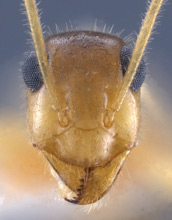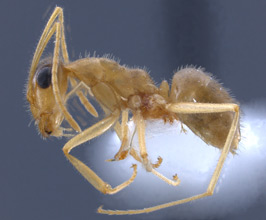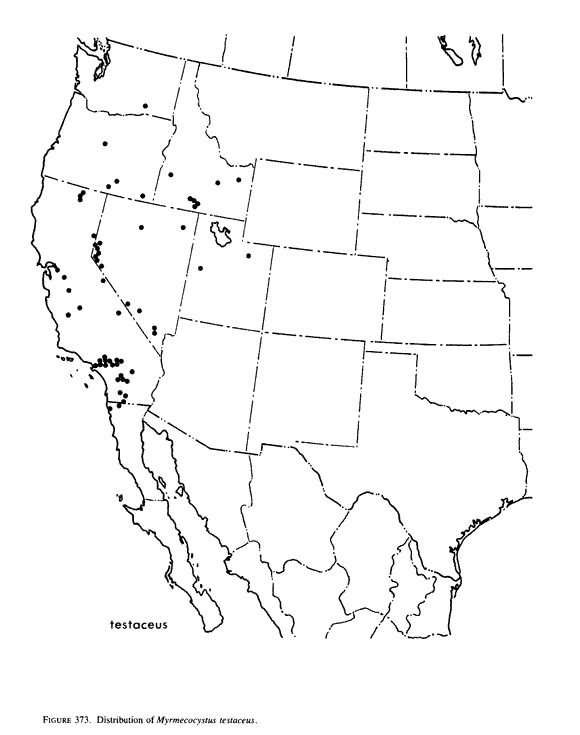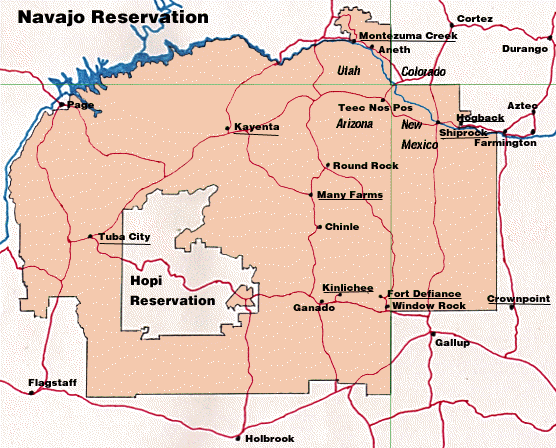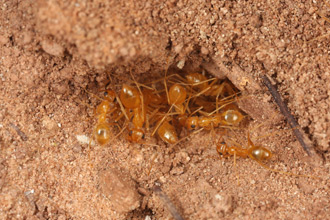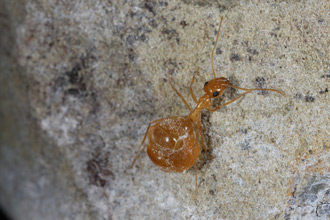- Identification
- The genus Myrmecocystus can be differentiated from other Nearctic Formicinae by their elongate maxillary palpi. The fourth segment is as long as, or longer than, the combined lengths of the two following segments. Myrmecocystus testaceus is similar to Myrmecocystus mexicanus but the workers are smaller, more robust and their polymorphism varies across a smaller range of worker size.
- Biology
- These ants are crepuscular foragers, with workers leaving the nest in a mass exodus shortly after sunset (see an account of this behavior below). Their ground nests are located in open areas, have large openings and are ringed by soil craters up to 20 cm in diameter.
- additional biology notes...
- Distribution
- Range
- United States and Mexico. Southern Washington to California, east to Idaho and Utah, and Mexico in far northern Baja California.
- Navajo Reservation Records
- Collection records being processed.
- Additional Notes (based on Snelling 1976)
- Foraging
- Myrmecocystus testaceus has an interesting way of initiating its nightly foraging period. Snelling's account provides a good description of this behavior:
- Workers begin to assemble at the nest entrance about 15-20 minutes prior to sunset and may completely block the entrance with their heads. Foraging begins within a few minutes of sundown and immediately before the onset of active foraging the interior of the crateriform tumulus may become completely blanketed with ants. At the proper moment, the mass of ants departs from the crater, as nearly simultaneously as possible, each ant proceeding individually. Within a few minutes after the exodus begins, the area around the nest, for up to a meter, is virtually covered with ants. Dispersal into surrounding areas and vegetation, however, is rapid and at a distance of four meters the ants are widely scattered.
- For about an hour after this initial exodus of foragers, individual ants continue to leave the nest at irregular intervals. The total number of ants departing during this hour is much less than that of the initial group. within about 15 min. of the onset of foraging activities, workers begin to return and thus continue for about two, rarely as many as four, hours. Apparently all individuals who will be foraging depart within the first hour following onset of activities, and all return within four hours.
- Nesting
- During the period of foraging activity, non-foraging workers may be engaged in excavation. Soil particles are carried to the surface. Since this species often nests in areas of clayey soil nearly devoid of small pebbles, it follows that the crateriform tumuli do not always consist of such material. In the chaparral of southern California the tumuli are built up of soil particles which are aggregated into small pellets. Such pellets are carried to the top of the crater and dropped over the side. These pellets disintegrate fairly rapidly through weathering and must constantly be replaced. In areas in which the soil includes coarse sand and small pebbles, the tumuli are constructed of these materials and are less subject to wind and rain damage.
- Habitat
- In Washington, Oregon, Idaho and Nevada this species is found in Sagebrush Steppe; in Nevada it also enters Pinon-Juniper Woodland. Habitats in California range from Coastal Sagebrush to Sagebrush Steppe, with the preponderance of the records from chaparral areas. In elevation testaceus ranges from 1400' to 6900'; in southern California the range is from sea level to 4300'. The bulk of the southern California records are from stations below 4000'.
- Mating Flights/Sexual Production
- The sexual forms are present in the nests in southern California in early spring and mid autumn, and fly following rains during these seasons. The flights take place in late afternoon. Shortly before the flight, workers emerge from the nest in large numbers and run out over an area up to one meter from the nest. Up to fifteen minutes before the flight, males emerge sporadically; some run about on the surface near the nest, a few take flight and alight on vegetation up to ten meters from the nest. The exit of the females is preceded by another outpouring of workers and more males. Females emerge and take flight, usually from the rim of the crater. Mating takes place in the air or on vegetation near the nest. In more northern areas the males and females are present during late spring and early summer, less commonly during the fall months. According to Cole (1934) alates are present throughout June and July near Twin Falls, Idaho.
- Repletes
- Myrmecocystus are better known to naturalists by their common name - honeypot ants. While there are numerous varieties of honeypot ants throughout the world this particular genus is restricted to dry habitats in southwestern North America. Individual species can be found from Washington, south to central Mexico and east to Texas. The genus is most diverse in southern California, which hosts eighteen of the twenty-seven named species. The common name of the ants from this genus highlights an unusual feature of their biology. One of the worker castes serves as a living food storage repository. These large workers, or repletes, have gasters that are able to expand to a remarkable degree.
- Repletes are a fascinating adaptation to arid and semi-arid habitat life. Myrmecocystus live in areas where rain is sparse and typically arrives seasonally. The moisture triggers plant growth and reproduction, which in turn creates food resources for many other organisms. Carbohydrate rich exudates of sap sucking insects (aphids and others), galls and extrafloral nectories can readily be gathered in great quantities by foraging ants. Over the course of the year nothing else compares to this seasonally abundant profusion of liquid nutrients. Repletes are an effective way of solving the problem of dealing with the boom and bust nature of these valuable liquid food resources.
- Nests of Myrmecocystus go deep underground and the repletes are typically located in the lower reaches of the nest. Snelling (1976) felt they were placed where there is permanent soil moisture. This positioning of the repletes in the soil column allows for the ants to be kept cool and maintained in a humid environment. The deeper confines of the nest are also presumed to be safer from predators that could potentially prey upon the nutrient rich ants. Other ants, badgers, coyotes and even humans have exploited honeypot ants as a food resource.
- Foraging ants collect honeydew and nectar, return to the nest and regurgitate their food to the repletes. These living storage units suspend themselves from the ceiling of a nest chamber. Individuals are often found in clusters while overall they may be found in numerous chambers in a colony. Engorged individuals can become confined to the chamber where they become filled with liquid. The repletes of some species become the size of small grapes. The transfer of food is reversed during leaner times of the year. Workers will tap their antenna upon the head, mandibles and antenna of a replete to solicit food, which is then readily provided to the repletes' nestmates.
- Etymology
- Morphology. testaceus = brick-colored, brownish yellow
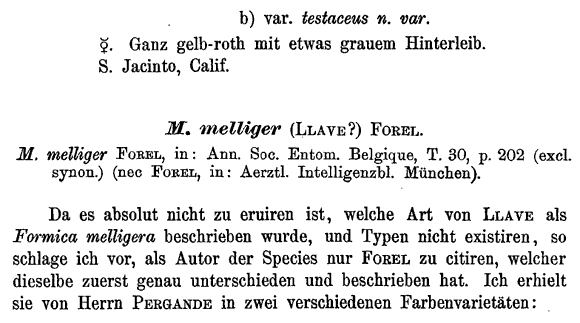
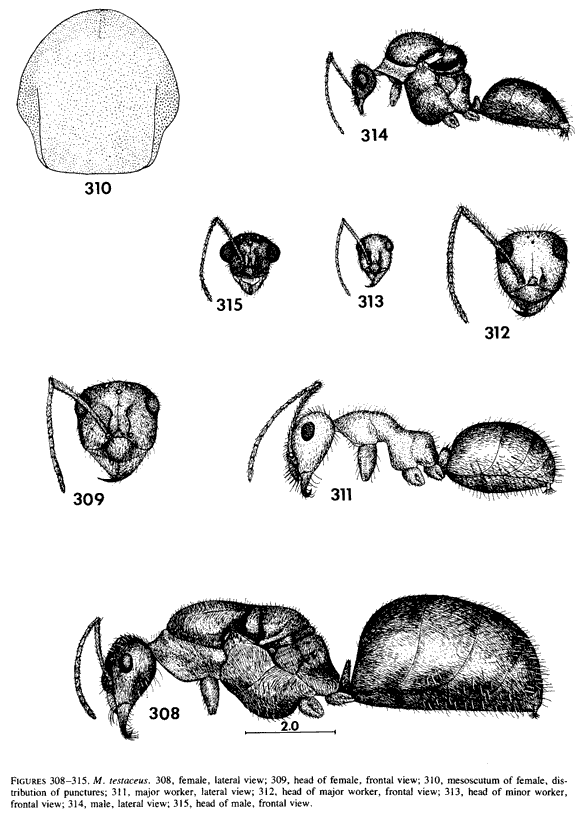
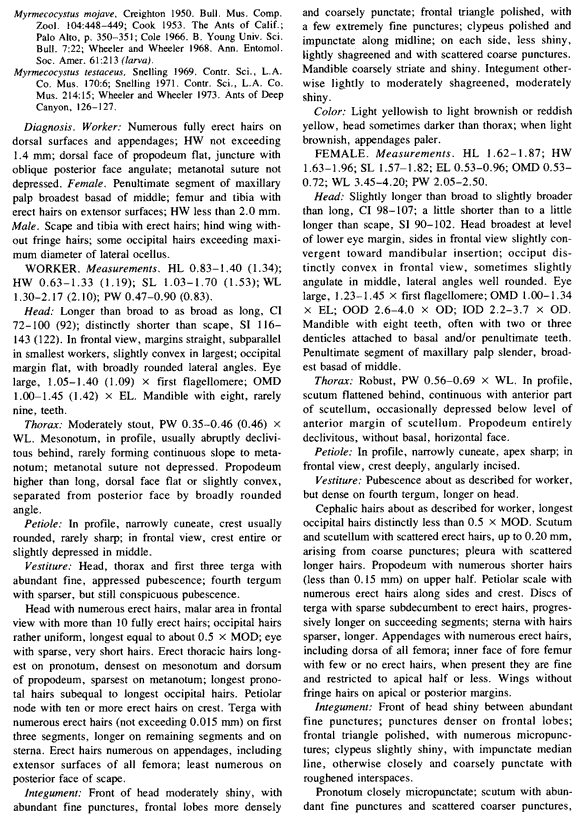
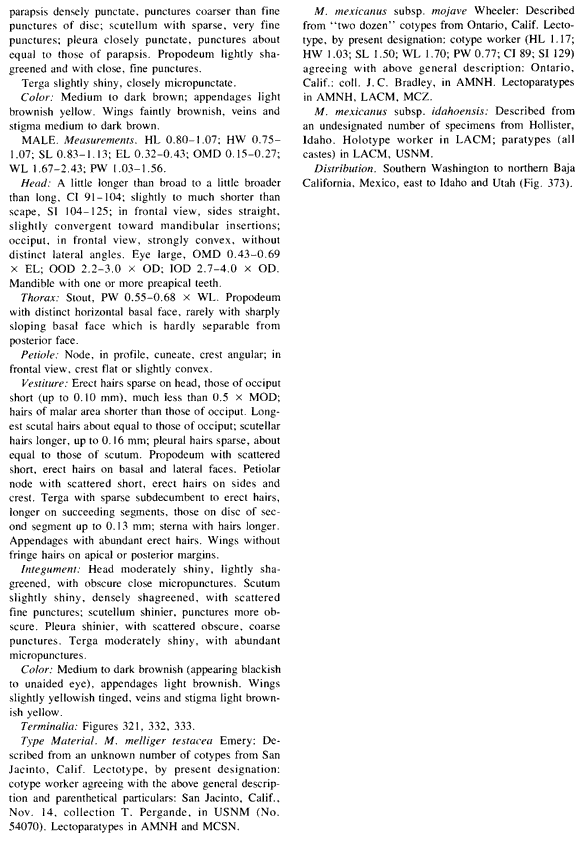
- Literature
- Cole, A. C., Jr. 1934. An annotated list of the ants of the Snake River Plains, Idaho (Hymenoptera: Formicidae). Psyche. 41:221-227.
- Emery, C. 1893. Beiträge zur Kenntniss der nordamerikanischen Ameisenfauna. Zoologische Jahrbücher, Abteilung für Systematik, Geographie und Biologie der Tiere. 7:633-682.
- Snelling, R. R. 1976. A revision of the honey ants, genus Myrmecocystus (Hymenoptera: Formicidae). Natural History Museum Los Angeles County Science Bulletin. 24:1-163.
- A note about these publications. The literature cited here is not meant to be an exhaustive list of papers published about this species.
Page authored by David Lubertazzi and Gary Alpert
